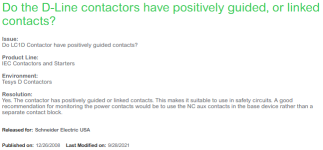milmat1
Member
I have a project where the customer specs will not allow the use of the VFD's STO safety function. They demand dual safety contactors in front of the VFD's.
They sent some sample drawings of their existing machines.
And they have installed dual Schneider contactors in front of each VFD as mentioned. However, they are using a LC1D09BD for example, which is not a safety rated contactor.
Is this a standard practice elsewhere(Australia, because they have dual contactors ? Can we use this line of contactors as such a safety device ??
They sent some sample drawings of their existing machines.
And they have installed dual Schneider contactors in front of each VFD as mentioned. However, they are using a LC1D09BD for example, which is not a safety rated contactor.
Is this a standard practice elsewhere(Australia, because they have dual contactors ? Can we use this line of contactors as such a safety device ??





